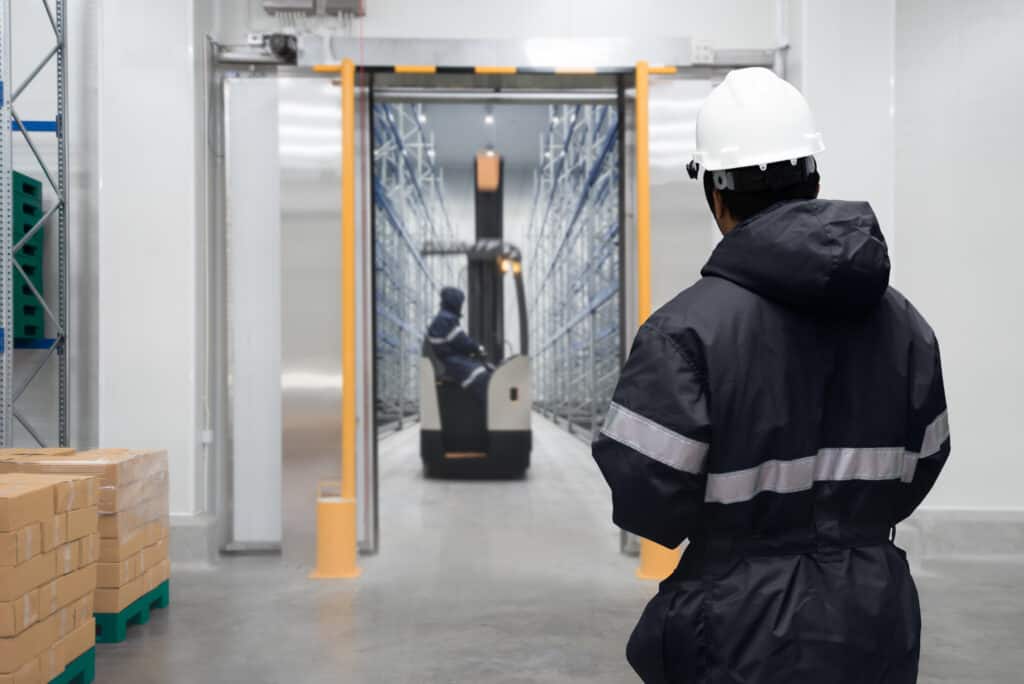
The freezer is one of the most notorious harsh places to work at in a warehouse/distribution center. You are expected to work in sub zero temperatures for long periods of time.
The effects of getting into a warehouse freezer to the body are immediately apparent once you step into one. Little icicles start to form around eyebrows and nostrils while extremities such as ears and hands go numb.
This is why it’s important to be adequately prepared with appropriate clothing and footwear if you are going to be spending many hours in a freezer.
Here are a few tips to keep warm while working a refrigerated warehouse:
Wear Heavy Clothing
In warmer parts of the warehouse (e.g. grocery, dry, etc.), you can wear light clothing like shorts for work. This is not going to be possible in a warehouse freezer, unfortunately.
Here, you will need to wear thick bib overalls, coats and pants. Alternatively, you can try layers of high quality thermal underwear followed by regular normal clothing such as jeans and hoodies.
In most freezers, pallets are easy to stack since most product comes in cardboard boxes. So heavy clothes you wear shouldn’t hinder your movement too much.
Just a hoodie isn’t gonna cut it. You need two or three layers of clothing if you’re going to be working in the freezer for hours on end.
Wear Insulated, Waterproof Work Shoes
This one is obvious but make sure to wear insulated and waterproof steel toe or composite shoes to prevent your feet from freezing.
The inside of your shoes will get wet from sweating and humidity commonly found in freezer environments. That’s why I prefer having an extra pair of shoes to rotate between them.
Switch the shoes during your break; it allows them to fully dry between uses and makes your feet as warm and comfortable as during the start of your shift.
Another alternative is to have two pairs of insoles which you can switch during your break. This allows one pair to dry and get back to its natural shape. Your feet will be as comfortable and warm after your break as during the start of the shift.
I keep two pairs of “Moneysworth” insulated insoles for exactly this reason.
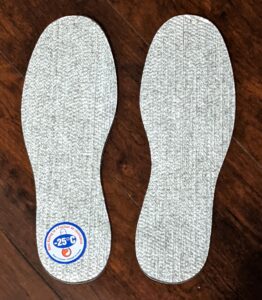
Freezer floors tend to be slippery due to ice forming on the floor. So make sure that the shoes you have are also slip resistant.
You also need to ensure that they are a bit bigger than your normal fit. You will spend all day working in them and getting an exact fit may pinch your feet.
Moisture in your shoes also slowly ruins them and causes odor. I use a pair of Moneysworth and Best shoe trees for moisture-wicking and odor removal. They also have an added benefit of stretching your shoes and making them fit better.
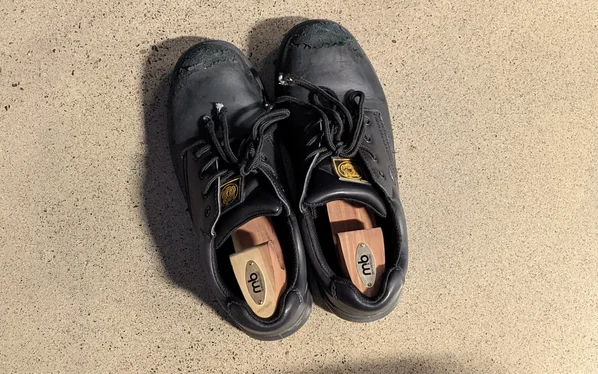
Wear Thermal Socks
In addition to thermal footwear, you also need wool socks to add another layer of protection from freezing.
Ensure that the socks are also sweat absorbent to prevent the sweat from freezing inside your boots.
I also recommend bringing an extra pair of socks with you so you can change to dry ones during your break. After a few hours in the freezer, your socks and your shoes will get wet due to the humidity. Wet socks make your feet colder.
I’ve seen people get frostbite on their feet as a result of frozen sweat getting trapped inside their shoes while working.
Be Constantly Moving
You need to be constantly on the move when working in a freezer warehouse. Being active warms up your body making the freezer climate more tolerable.
If your work doesn’t involve lots of movement, for example of you’re a reach truck operator, you might need to wear more layers of clothing to stay warm.
Wear Thermal Gloves
Extremities like hands, feet and ears are the first to get cold because the body redirects blood flow to these places to vital organs when in a cold environment like the freezer.
Get thick touchscreen freezer gloves if your warehouse doesn’t provide them and uses RF scanning instead of voice picking. Or use a stylus instead.

I prefer wearing just one pair of gloves because I find two or more gloves can get too tight on my hands which reduces blood flow making them colder.
Also consider placing hand warmers inside your gloves if your hands still get too cold. I like to keep a box of these inside my locker to use when I’m working in the freezer.

The most effective but most expensive way to keep your hands warm throughout your shift in the freezer is to use heated electric gloves.
Ororo Wear makes heated electric gloves, which are durable electric gloves that are touch screen compatible and water resistant. They are also slip resistant so you can handle cases firmly without them sliding off your hands.
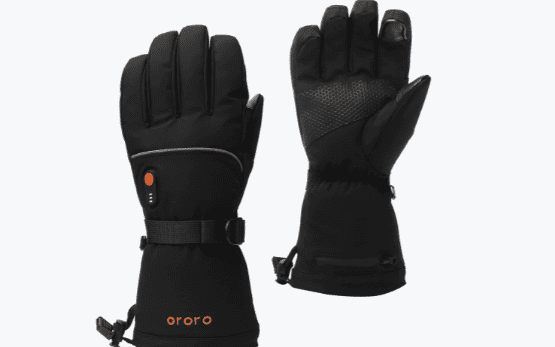
Eat More Carbs
Your body uses a lot of energy to keep you warm. Therefore, you need more food than normal to replace these lost calories.
I recommend complex carbohydrates such as potatoes, lean beef, chilli and peanut butter consumed before work and during your break.
Come Out of the Freezer Area Frequently
Do not stay in the freezer for hours on end. Use every opportunity you get to come out of the freezer for a few minutes before getting back in.
For example, if you have to get out of the freezer after finishing an assignment (e.g. to stage pallets for shipping) do so as quickly as you can.
Those few minutes you spend outside the freezer area help a lot in raising your body temperature.
Wear Thermal Headgear
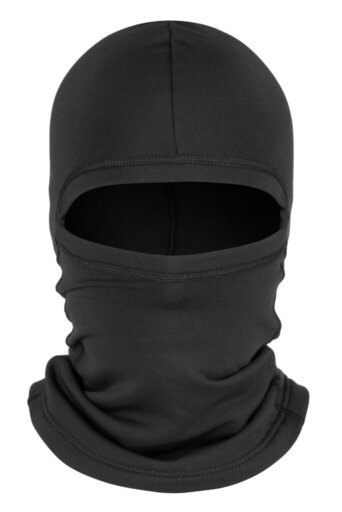
It’s important to protect your head and face from the extreme cold of the freezer warehouse.
Cold weather balaclavas, beanies and ear muffs help in this regard. Only get ear muffs if you don’t use voice picking i.e., if you don’t wear headset at your job.
Whatever you decide to wear on your head, make sure to keep your ears covered as they’ll go numb if exposed to the cold for too long.
Stay Hydrated
In the freezer climate, your body loses a lot of water via respiration. This is water needed for metabolism to generate heat that keeps you warm.
Due to the cold, however, the thirst mechanism is reduced. So you may not feel thirsty but you will get tired and your performance will reduce if you don’t drink water.
Remember, you will get slower the more tired you are. Moving slower means you will feel colder due to reduced activity.
It is therefore important to have a bottle of water with you to sip from while you work.
Do Stretches
Before you start working, it’s important to do stretches to warm up your body.
Stretches also reduce the risk of muscle cramps and injury.
Alternatively, you may also do calisthenics exercises like push-ups to prepare your muscles before you start working.